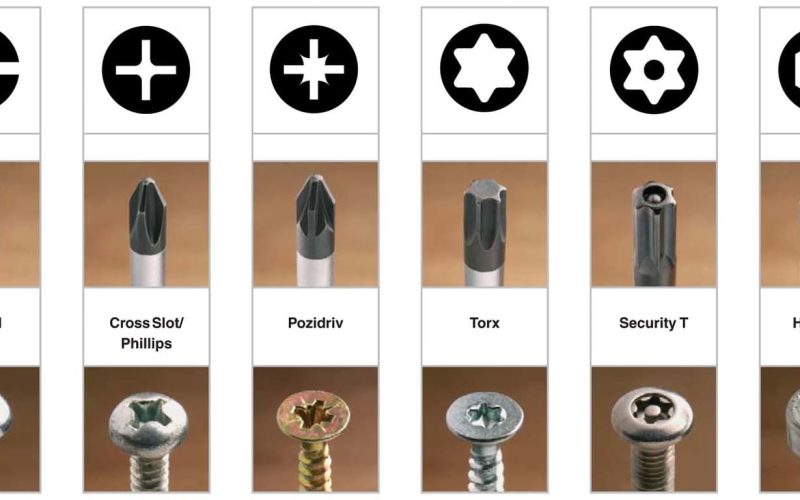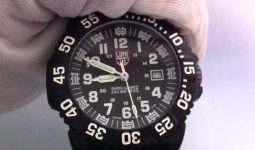Given the variety of the different types of screw heads available, it would take weeks to learn each one’s uses and characteristics, let alone try to figure out how to tell it apart from the others.
When you realize that you can tell screws apart very easily based on one important physical characteristic—the screw head—life becomes easier in such situations.
Learning to differentiate between different screw head types is advantageous because it makes it simpler to determine the type of screw and which driver should be used with it.
This is crucial because choosing the incorrect driver could harm the screw and, in turn, the material you’re driving it into.
Stripping the head can become a nightmare where you must drill it out later or turn it back out with pliers.
What will be visible is the screw’s head. Your project’s surface will be covered by the threaded part, leaving the head exposed or flush with the surface.
While some head shapes contribute to the final product’s appearance, they typically serve other purposes.
Additionally, using force and the screw’s mechanics, the head shape drives the screw into the material.
Here are some of the different types of screw heads.
1. Flat Screw Head
Flat screw heads are countersunk, which ensures that the screw head is concealed by sitting completely flush with or slightly below a surface.
This prevents objects from protruding and makes the finish much neater and more appealing, essential in sofas and other frequently used or passed-by furniture.
From the top of the head to where the threads and the head meet, flathead screws can have a range of angles or degrees.
Although 90 degrees, 100 degrees, and other angles are available and used, 82 degrees is the accepted standard. The countersunk hole needs to be wider and shorter the higher the degree.
Due to the single opening for flat screwdrivers, flathead screws are sometimes called slotted head screws.
Despite their widespread use and low cost, screws with these heads are more prone to stripping; this is built into their design to prevent overtightening.
2. Raised Screw Head
Raised screw heads, also known as oval-shaped, have an angle similar to flat screws, but their heads are more dome-shaped rather than entirely flat.
As a result, the head of such screws will protrude slightly from the surface. You could also countersink these screws, depending on the angle and finish you desire.
These screws serve more of a decorative than a functional purpose because of their domed heads, but they are still fairly effective workers. This is one of the different types of screw heads.
3. Bugle Screw heads
Most screws made for drywall and plasterboard have bugle heads. Similar in appearance to a flat screw head, but with a curved shape that prevents damage to surfaces instead of an angle beneath the surface of the head.
In addition to not requiring any pilot holes before use because they are self-drilling, bugle screws’ distinctive shape allows them to distribute stress over a larger surface area than flat screws.
4. Binding Screw Heads
Since binding screw heads are non-countersunk, they don’t have an angle and are visible on the project’s surface where they are positioned above it. To accommodate the screw head, you won’t need to make a countersink divot.
Binding screws have a slightly rounded head and can be used for various projects. These screws, which have male and female sides, screw into one another.
Binding screw head types are frequently used in bookbinding, but you can also use them to hold leather, fabric, swatches, and other items together. This is one of the different types of screw heads.
5. Domed Screw Heads
One of the most prevalent head shapes is the domed head. These are perfect for projects where you don’t need to conceal the screw head as you would with a flat head, like an ottoman that uses decorative screws that stick out of the fabric.
The flat interior of the dome helps the screw to stop where it needs to, just at the surface, while its shape produces an aesthetically pleasing design on the surface. This is one of the different types of screw heads.
6. Flange Screw Heads
Sometimes, frame screws are used to refer to flange screws. These screws have a head that protrudes from a circular flange directly beneath the head and can be either circular or hex-shaped.
For some projects, the flange replaces the washer and aids in keeping the screw in place. The flange is one of the different types of screw heads.
7. Truss Screw Heads
Truss screw heads are typically wider than other screw heads and have a slightly rounded surface. This was done on purpose and served the intended purpose very well.
When sheet metal is involved or when large holes are needed (because the truss head is so wide, it won’t fit through the hole completely), these screw heads are frequently used.
8. Combination Heads
There are other variations and combinations of these screw head types, even though these are the more prevalent ones.
Pay close attention to whether or not the screws need to be countersunk. You can always look at the head to determine this.
Furthermore, A screw that doesn’t need countersinking will be flat under the head, while a screw with an angular shape will be underneath the head.
You should also take your project into account. Do you prefer a flat screw’s smooth finish over the rounded head sticking out from the surface?
However, as long as you know how each screw head will impact the assembly and final appearance, a combination of screw heads may satisfy your needs.
9. Phillips Screw Heads
Phillips screws, another extremely popular screw head design, are well known for their cross shape, which aids in self-centering and prevents drilling at unnatural angles. As a result, you can install them with any drill because they won’t move under pressure.
However, use caution when using excessive force because it can be a useful ally until it quickly strips the head off. Of course, the screw’s construction material will impact this.
10. Pozidriv Screw Heads
The additional grooves on Pozidriv screws give them their star-shaped appearance, which is similar to the shape of Phillips screw heads.
However, their resemblance to Phillips screws has a benefit—in most cases, you can remove screws with these heads using a Phillips screwdriver.
Pozidrive screws are stronger than their Phillips family cousins under force, but you might be put off by the need for a particular screwdriver or driver bit to match the grooves on these screws.
This is one of the different types of screw heads.
11. Hex Screw Heads
There are two types of hex screw heads: external and internal. The hexagonal, protruding heads of external screws have a bolt-like appearance.
Some external hex screw heads for screws have built-in flanges, while others only have a hexagonal head.
These heads must be installed or removed using a socket or a wrench; good leverage is possible with these screws because you must turn the entire head rather than just the internal portion.
You can obtain a lot of torque without worrying about stripping the head.
Furthermore, furniture construction and assembly frequently employ internal screw heads with a hex shape. This is because, unlike slotted or Phillips screw heads, they are robust enough to withstand the Allen wrench during installation and removal. As a result, the outcome is quite pleasing.
12. Quadrex Screw Heads
Quadrex types of screw heads combine square recesses and Phillips, also called Phillips square drive heads.
Therefore, quadrex screw heads also resemble Phillips squares in appearance, except that the cross’s middle is square rather than pointed, preventing stripping under excessive force. This is one of the different types of screw heads.
13. Star Screw Heads
As the name implies, star-shaped heads are a feature of star screw heads. These screws come in various shapes and sizes, all with star-shaped screw heads.
For instance, the central 8-point star in square recesses is made up of double squares. With a Robertsons bit, you can use these to drive them. Robertsons can be made with up to three squares, allowing for the creation of a 12-point star.
Furthermore, these are most frequently used to stop the screw from stripping when a lot of force is involved.
These screws are frequently found in car interiors. This is one of the different types of screw heads.
14. Square Recess Screw Heads
These screw heads, also known as Robertsons, have a central square point that helps to prevent cam outs.
The bit protrudes on a square taper and drives screws with these heads. Thus, holding the bit in place is unnecessary because the design becomes self-holding.
15. Star Screw Heads
Star-shaped heads come in various designs that take the form of stars. Two Robertson’s squares in the middle of the double-square drive create an eight-pointed star.
You can drive it with a Robertson’s bit or a special one for the double square for applications requiring more torque.
A 12-point star is also created by a triple-square of three Robertson’s squares.
Furthermore, The most frequent application of triple-squares is when a lot of force is required without stripping the screw. They are primarily found on internal car parts, such as drivetrain elements.
16. Torx Scre Heads
Most people rarely use the Torx screw bits in their drill bit sets. Torx screws are frequently used on electronic devices like computers and DVD players because they have a six-pointed star shape in the middle.
The fact that these screws can prevent cam out, which is particularly useful when building electronics, is one of the reasons they have grown in popularity in recent years. This is one of the different types of screw heads.
17. Tri-Wing Screw Head
Both the bit shapes required to use them and the Tri-Wing screw head shapes are registered trademarks of the Tri-Wing company.
Although the term “Y-Type shapes” is sometimes used to describe them, the actual Tri-Wing shapes are distinct.
These are one of several varieties of tamper-proof security screw head shapes that are sufficiently uncommon that it will be unlikely for someone to access the bit required to tamper with your items easily. For lack of a better term, these Y shapes are more rotational.
18. Slotted Screw Heads
For a wide flat, head screwdriver bit, they merely have a straight line carved out of them. Due to the high surface area and torque you can apply, they are less likely to strip, but this is more likely because it is simpler for the bit not to sit flush at the bottom of the slot.
Use one of these common bits because some will have a smaller Phillips shape in the center. Combination heads are the names for these mixtures.
19. Sentinel Screw Heads
The Sentinel shape is similar to a spinning saw blade or a ninja star, making it one of the security-conscious screw heads.
The layout provides the driver bit with four flat areas to push against when tightening, all located around the exact center.
This small amount of space from the center enables you to use a power driver or a manual screwdriver to apply more force with less effort. Simply put, you get more torque from these.
Additionally, it will be extremely rare for anyone to have the desire to tamper with your equipment on hand.
20. Pin Screw Heads
Because the distinguishing feature is compatible with all screw head shapes, pin screw heads offer the highest level of security. The difference is that the bit cannot be seated into the screw head because of a pin in the center.
Therefore, before using the screw, you must use a special bit to accommodate the pin. This is a very creative answer to the tampering and security issues. This is one of the different types of screw heads.
21. Button Screw Head
Standard screws don’t have the same appearance as button-head cap screws. The low-domed head of these bearings gives them a wider bearing surface.
When you want the area to look tidy and clean, a button screw is an ideal screw because it has a more finished appearance.
These screws lack the socket screw’s strength. They have chambered sides, resulting in a curve extending to the head’s base. This is one of the different types of screw heads.
22. Pan Screw Head
For wood, a pan head screw is frequently employed. This screw is self-tapping, self-drilling, machine, and non-countersunk.
A pan screw has a flat, broad head with rounded edges. The screw’s head rests on top of the substance. These broad screws have higher edges and a larger diameter.
The deep drive slot on a pan screw helps to protect the screw even when the torque is increased. There are several pan screws, one of which has a single cut in a slotted head.
Thanks to these cuts, you can use a pan screw with any screwdriver. These screws are frequently used on auto and industrial engine components.
23. Round Screw Head
Domed screws are another name for round screws. The head of these screws is enlarged and rests on the material. To help spread the weight over a larger area, the screw’s underside is broad.
By doing this, the screw connection’s strength is strengthened. Round screws include self-tapping and machine screws as well.
24. Fillister Screw Head
A pan head screw with a fillister head is similar to a machine screw in appearance. A fillister screw has a larger head than a regular screw, making it ideal for joining metal to wood or metal to metal.
They are machine fasteners with slotted heads, like these screws. These screws may also be referred to as cheese head screws.
Counterbore holes are most frequently used with a fillister head screw. Due to their deep heads, you can also use them for reciprocating and slot drives.
These screws are commonly used in auto or machine shops. This is one of the different types of screw heads.
25. Sockets Cap
A socket cap screw is a machine screw distinguished by its cylindrical, barrel-shaped head. With a hexagonal socket, it is utilized.
Thanks to their shape, you can use them in locations without needing dampening fasteners. This kind of screw is embedded beneath the material’s surface. They offer a solid and dependable joint and are corrosion-resistant.
26. Supadriv
In the 1980s, Supadriv screws were widely used. They were twin-thread screws with a quick drive. They were created to be applied in areas without pilot holes.
These screws were necessary because you couldn’t use many screws from the 1980s without a pilot hole.








